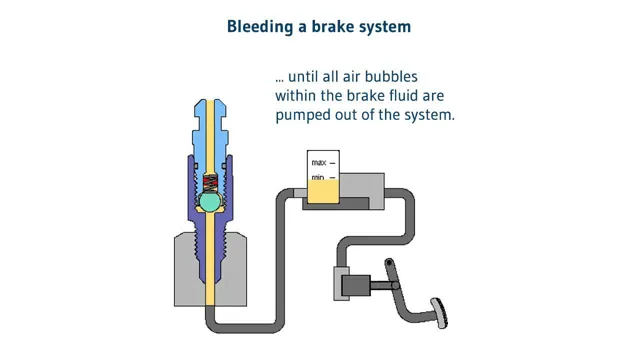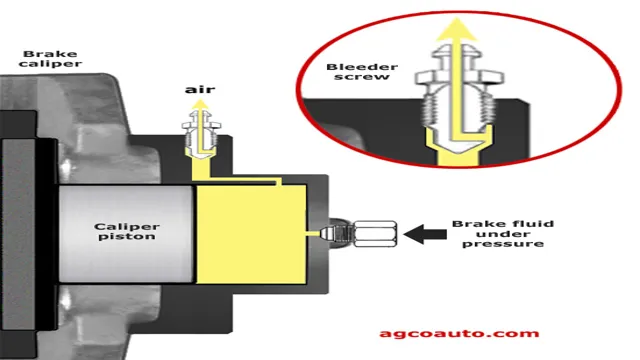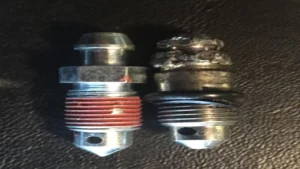When it comes to maintaining your vehicle, making sure your brakes are in good working condition is crucial for both safety and performance. One tool that can help with this is a brake bleeder. But how exactly does a brake bleeder work? In simplest terms, a brake bleeder helps remove any air that may have gotten into the brake lines, which can cause issues with braking performance.
It does this by creating suction that pulls the air out, allowing for a more efficient and effective braking system. Think of it like using a straw to remove unwanted bits from a drink – the brake bleeder uses a similar principle to make sure your brakes are in tip-top shape. Keep reading to learn more about this handy tool and how it can benefit you and your vehicle.
What is a Brake Bleeder?
A brake bleeder is an essential tool used to remove air from the brake system in a car or truck. It works by creating a vacuum that sucks out the air from the brake lines, allowing for smooth and efficient braking. The process is quite straightforward: first, the bleeder valve on the brake caliper or wheel cylinder is opened.
Then, the brake bleeder is connected to the valve, and a vacuum is created by pumping the handle or using an electric pump. The air is then pulled out of the brake system into a container, leaving only fluid in the lines. This is important because air in the brake system can cause the pedal to feel spongy or soft, reduce brake power, and even cause the brakes to fail altogether.
By using a brake bleeder, you can ensure that your vehicle’s braking system is performing at its best, allowing you to drive safely and with confidence on the road.
Definition and Function
A brake bleeder is a tool designed for removing air bubbles that can get trapped in a vehicle’s brake lines. This is important because air bubbles can cause the brakes to malfunction, resulting in potentially dangerous driving conditions. The brake bleeder works by creating a vacuum that draws out the air, allowing the brake fluid to flow through the lines unimpeded.
This process requires a steady hand and careful attention to detail, but it can be done by most DIY mechanics with a little practice. So, if you’re experiencing spongy brakes or notice a decrease in stopping power, it’s time to consider using a brake bleeder to get your brakes back in top shape.

Why do you need to Bleed Brakes?
If you’re wondering why you need to bleed brakes, it’s because air bubbles can get trapped in your brake lines, causing your brakes to feel spongy and less responsive. This can be dangerous, as it impairs your ability to stop quickly in an emergency situation. Bleeding your brakes means removing the air bubbles from your brake lines so that your brakes work as they should.
So how does a brake bleeder work? It’s actually quite simple. A brake bleeder is a tool that attaches to your brake system and allows you to remove air bubbles from your brake lines. The bleeder valve is opened, and this releases any air and brake fluid that is trapped in the line.
As you pump the brake pedal, fresh brake fluid fills the line, pushing out any remaining air bubbles. Once all the air is out, you’ll have a brake system that is much more responsive and safer to use. So if you notice that your brakes feel spongy or less responsive than usual, it’s time to bleed your brakes.
Common Issues with Brakes
Bleeding brakes is a crucial maintenance task that helps ensure your vehicle’s safety. Over time, air can enter the brake system, causing the brakes to feel spongy or unresponsive. Bleeding the brakes removes any air bubbles that have entered the system and ensures that the brake fluid is circulating properly.
This simple task can help avoid issues like brake failure and accidents on the road. When you press the brake pedal, the calipers generate a hydraulic force that slows down or stops the vehicle. If there is air in the system, it can cause the hydraulic force to become weak, which can lead to brake failure.
Bleeding the brakes is an easy and straightforward process that can be done in your own driveway with a few tools. In conclusion, bleeding brakes is crucial to maintaining your vehicle’s safety, and it’s a necessary task that should be carried out regularly.
Purpose of Brake Bleeding
Brake bleeding is an essential maintenance task for your vehicle. But why do you need to bleed brakes? The answer is simple – to ensure that your brakes work correctly. Over time, air can build up in the brake lines, which can cause a spongy or unresponsive brake pedal.
Bleeding the brakes removes any air that has accumulated in the system and replaces it with fresh brake fluid, resulting in improved braking performance. Additionally, regular brake bleeding can help prevent brake failure and extend the lifespan of your brake components. Overall, bleeding your brakes is an essential step in maintaining your vehicle’s safety and should be done regularly to ensure optimal performance.
Types of Brake Bleeders
Brake bleeders are essential tools for any mechanic, enabling them to accurately and efficiently purge air bubbles from hydraulic braking systems. There are various types of brake bleeders available, each with their unique features and functionalities. The most common types of brake bleeders include pressure bleeders, vacuum bleeders, and reverse bleeders.
Pressure bleeders use pressurized fluid to force air out of the brake system, while vacuum bleeders rely on vacuum power to draw air out. On the other hand, reverse bleeders work by pushing clean fluid directly into the brake caliper or wheel cylinder, which forces the air out. No matter the type, all brake bleeders work to ensure that the system is free of air bubbles, improving braking performance and overall safety.
So, the next time you need to quickly bleed your brakes, consider investing in one of these fantastic tools.
Manual
Manual brake bleeders come in several types, each with its advantages and disadvantages. The most basic type is the hand-held pump-type bleeder, which requires a manual pump to create a vacuum. This type can be quite effective for small and simple brake systems.
Another type is the gravity bleeders, which work by allowing the brake fluid to flow through the system through gravity. This type is suitable for those who have difficulty operating a pump, although it can take longer to complete the process. The third type is the pressure bleeders, which use air pressure to force brake fluid through the system.
This type is ideal for larger and more complex brake systems, but it requires a compressor to operate. No matter which type of manual brake bleeder you choose, it is essential to keep the brake fluid level maintained, follow the manufacturer’s instructions carefully, and be patient throughout the process.
Vacuum
When it comes to brake bleeding, there are two types of vacuum bleeders to consider: hand-held and pneumatic. Hand-held vacuum bleeders, as the name suggests, are operated manually, and they usually come with a pump and a reservoir. To use this type of bleeder, you attach the pump to the brake bleeder valve and start pumping until you build up a vacuum.
This process creates suction and draws the brake fluid from the caliper into the reservoir. On the other hand, pneumatic vacuum bleeders work with an air compressor, using air pressure to create suction. These bleeders come with a container that holds brake fluid, and they have a hose that attaches to the brake bleeder valve.
Once you connect the hose, you open the valve, and the suction created by the pneumatic vacuum draws the brake fluid from the caliper into the container. In conclusion, both types of brake bleeders are great options for bleeding brakes, but it comes down to personal preference and the type of project you’re working on.
Pressure
When it comes to brake bleeders, there are a few different types to choose from depending on your needs. One type of brake bleeder uses pressure to force out air bubbles and replace them with fresh brake fluid. These pressure bleeders usually come with a hand pump or an air compressor attachment to provide the necessary pressure.
They’re best used for larger systems or those with hard-to-reach bleeder valves, but they can be messier than other types of bleeders, especially if you’re not careful. Another type of brake bleeder is a vacuum bleeder, which pulls out air bubbles using suction rather than pressure. These are typically easier to use, especially for beginners, and can be less messy, but they may struggle with larger systems.
No matter which type you use, though, it’s important to regularly bleed your brakes to ensure proper function and safety on the road.
How does a Brake Bleeder Work?
If you’ve ever wondered how to use a brake bleeder, you’re in the right place! A brake bleeder is a simple tool that helps remove air bubbles and other contaminants from your brake lines. Essentially, it uses suction to pull brake fluid through your brake system, pushing out any air or other substances along the way. The process is fairly simple: you attach the bleeder to your brake lines, pump the device to create a vacuum, and then wait for the fluid to flow through.
In some cases, you may need to repeat the process a few times to fully remove all contaminants. Using a brake bleeder can help ensure that your brakes perform at their best and can help prevent accidents on the road. So, next time you need to perform maintenance on your brakes, consider using a brake bleeder to make the process a little easier and more effective.
Step-by-Step Process
A brake bleeder is a tool used to remove air bubbles from the brake system of a vehicle, ensuring that the brakes operate correctly. It works by creating a vacuum to draw brake fluid from the caliper or wheel cylinder towards the master cylinder. This process of bleeding the brakes ensures that all air bubbles present in the brake line get eliminated, allowing for a better and more efficient brake.
The brake bleeder will connect to the brake system through the bleeder screw located on the brake caliper. Once attached, it will create a compression that removes air bubbles from the bleeder screw. Therefore, the brake bleeder is a handy tool for mechanics, car enthusiasts, and anyone who wants to ensure their brakes are functioning optimally.
With a brake bleeder in place, you can expect your braking system to perform consistently, providing a safer and more comfortable driving experience.
Explanation of Pressure and Vacuum Systems
If you’ve ever wondered how a brake bleeder works, it’s all about pressure and vacuum systems. Essentially, a brake bleeder is a tool used to bleed air out of a vehicle’s brake system, to ensure that the brakes function effectively. When you use a brake bleeder, you create a low-pressure environment that helps to suck any excess air out of the brake lines.
This works through a series of different components, such as a hand pump or air compressor, which helps to create a vacuum in the brake system that draws out air. In addition, you’ll also need to have reservoirs for the old and new brake fluid, as well as a tube that connects the brake bleeder to the brake system. All of these components work together to create a highly effective brake bleeder that can help to reduce the risk of brake failure and ensure that your vehicle is always operating safely on the road.
Benefits of Using a Brake Bleeder
How does a brake bleeder work? A brake bleeder is a tool designed to remove air bubbles from brake lines, which can cause the brakes to feel spongy and less responsive. The process consists of attaching the tool to the brake caliper or wheel cylinder and pumping out the old fluid while simultaneously introducing new fluid. The brake bleeder creates a vacuum that draws the fluid through the system, flushing out any trapped air.
This can save time and money by eliminating the need to take your vehicle to a mechanic for brake maintenance. In addition to improving brake performance, using a brake bleeder can also extend the life of your brake components by removing harmful contaminants that may have built up in the system over time. Overall, a brake bleeder can be an invaluable tool for any vehicle owner who wants to keep their brakes in top condition and avoid costly repairs down the road.
Improved Brake Performance
If you’re looking to improve your vehicle’s brake performance, using a brake bleeder can be an incredibly effective solution. By removing any air that’s built up within the brake system, you can ensure that your brakes are working as efficiently as possible. Not only does this improve the overall safety of your vehicle, but it can also help extend the lifespan of your braking system.
When you use a brake bleeder, you’ll be able to quickly and easily purge any air bubbles from the system, which will ultimately lead to a much smoother, more responsive ride. So if you’re serious about getting the most out of your vehicle’s braking system, be sure to consider using a brake bleeder as part of your regular maintenance routine. It’s a simple yet effective way to keep your brakes working at their absolute best.
Reduced Risk of Brake Failure
When it comes to braking your vehicle, safety should be your top priority. One way to ensure your brakes are working properly is by using a brake bleeder. Not only does a brake bleeder help to remove air and moisture from your brake system, but it also reduces the risk of brake failure.
This is important because if air or moisture gets into your brake lines, it can cause soft or spongy brake pedals, reducing your ability to stop your vehicle in an emergency situation. By using a brake bleeder, you can prevent these issues and maintain the optimal performance of your brakes. So, if you want to enjoy a safer and smoother ride, investing in a brake bleeder is definitely worth considering.
Increased Safety on the Road
If you’re looking to increase safety on the road, using a brake bleeder can greatly benefit you. A brake bleeder is a device used to remove air bubbles from the brake system, which can cause a loss of pressure and reduce the effectiveness of your brakes. By using a brake bleeder, you’ll be able to ensure that your brakes are functioning at their fullest potential, allowing you to stop quickly and effectively when you need to.
Additionally, this tool can save you money in the long run by preventing costly repairs that may be needed if your brakes are not functioning correctly. So why not invest in a brake bleeder and increase your safety on the road?
Conclusion
In conclusion, a brake bleeder is like a magician’s wand for your car’s brakes. It works by using a vacuum or pressure method to remove any air bubbles or contaminants from the braking system, ensuring that your vehicle stops safely and effectively. So next time you hit the brake pedal with confidence, remember that it’s thanks to the brake bleeder working its magic behind the scenes!”
FAQs
What is a brake bleeder and how does it work?
A brake bleeder is a tool used to remove air bubbles from brake lines in order to ensure proper braking function. It works by attaching the tool to the brake system and utilizing pressure to force air out of the system.
Why is it important to bleed your brakes?
Bleeding your brakes is important because air bubbles can compromise the effectiveness of your braking system. Properly bleeding your brakes can ensure that they are functioning at their best and can help prevent accidents.
When should you bleed your brakes?
You should bleed your brakes whenever they feel soft or spongy, or if you have recently replaced any brake components. It is also recommended to bleed your brakes annually as part of routine maintenance.
Can you bleed your brakes on your own, or should you have a professional do it?
You can technically bleed your brakes on your own with the proper tools, but it is recommended to have a professional do it if you are not confident in your ability to do so. Improperly bleeding your brakes can result in a dangerous situation on the road.
What are the common types of brake bleeders?
The common types of brake bleeders include vacuum bleeders, pressure bleeders, and manual bleeders. Each type has its own benefits and drawbacks, depending on the specific situation.
Can you bleed brakes without a bleeder tool?
Bleeding brakes without a bleeder tool is possible, but it is more difficult and time-consuming. One method involves attaching a tube to the bleed valve and submerging the other end in a container of brake fluid.
How often should you replace your brake fluid?
It is recommended to replace your brake fluid every 2-3 years. Brake fluid can become contaminated and lose its effectiveness over time, so regular replacement is necessary to maintain optimal brake function.






